Large sail, small sail, or in between?
These are the choices faced by a windsurfer who anxiously looks forward to getting on the water and enjoying their favorite sport.
Choosing the right sail need not be rocket science, as there are some factors to consider before your sail is rigged on the mast for your session.
In this article, we’ll see that choosing the right sail size depends mainly on the wind strength, your weight and skill level.
You’ll also learn how those and other factors play together, and how you can choose the right sail size for you.
- Which Sail Size Ranges Are There?
- 5 Factors Which Influence Your Choice of Sail Size
- What Happens If I Choose the Wrong Sail Size?
- 5 Practical Tips to Help You Choose the Right Sail Size
- Sail Size Terminology: What Are Square Meters?
- How Does Sail Size Relate to Planing?
- What are Entry and Beginner Sails?
- What Are Battens, Cambers or No-Cambers?
- What If I Only Have One Sail?
- Conclusion
- You Might Also Like…
Which Sail Size Ranges Are There?
Sail sizes typically range from 2.0 to 10.0 m² (there are smaller and bigger ones available, though).
If you own a few in different sizes, you will be choosing the one that is best for the conditions. High wind will call for a smaller sail, while light wind will demand that you rig larger.
If you only own one sail, I highly recommend you learn more about downhauling and how it can increase the usable range of your sail.
Before you buy a sail, discuss your size and needs with the shop you are buying from, as a 5.5 m² might be a fine all-around sail for some but might not be right for you.
5 Factors Which Influence Your Choice of Sail Size
1. Your Weight
A heavier sailor might choose a 6.5 m² sail in medium-light winds, while a small person might get the same kind of ride with a much smaller sail.
It will take a bigger sail to power up a board of a heavy weight sailor as opposed to a lighter sailor.
In stronger wind, however, a heavier and/or stronger sailor is able to manage a bigger sail than a smaller person, using their strength and weight within the harness to balance against the force of the wind.
2. Wind Strength
A major factor when deciding which sail to use is the wind that day, and we’ll give you specific sail size recommendations according to different wind speeds a little bit further down.
Wind strength is the deciding factor in choosing the sail for your session. You do not want to be overpowered or underpowered by selecting a sail that is wrong for the conditions.
Knowing the wind and water conditions before you leave your house is very important to your fun as well as safety.
3. Your Skill Level
All other factors being equal, a less experienced windsurfer will rig a smaller sail than a more advanced windsurfer.
This is because as your skill level increases, you learn to control your rig more effectively.
This, in turn, will allow you to use a bigger sails and go faster in stronger winds and generally more challenging conditions, where a beginner would be overpowered and unable to maintain control of their gear with that sail size.
On the other hand, you will also observe the following seeming (but not actual) contradiction: as you advance, you will be able to start planing sooner with a smaller sail than a less experienced windsurfer.
That’s because you’ve refined your technique and increased your ability to translate the power of the wind more efficiently into forward movement and speed.
In other words, as you progress and increase your skill level, you effectively increase your usable range of sail sizes for a given wind situation.
4. Your Board
Everything else being equal, a smaller board (less volume) requires a bigger sail to start planing.
That’s because smaller boards generate less lift, which means they are partially submerged underwater, which generates more drag.
Therefore, they need more power to be pulled out of the water and accelerated than high-volume boards, which are floating more on the surface to begin with.
That’s why it’s easier to start planing on Freeride and Race boards than on Freewave or Wave boards, the former two having considerably more volume than the latter two.
5. Your Fin
Everything else being equal again, a longer, straighter fin creates more lift than a shorter, curved fin.
This means that a board with a long, straight fin will start planing much easier than the same board with a short, curved fin – meaning you can use a smaller sail in the former case and would need a bigger sail in the latter.
This is, incidentally, one of the reasons why Race and Freeride boards always have longer, straighter fins than Freewave and Wave boards.
What Happens If I Choose the Wrong Sail Size?
First of all, we should clarify what we mean by the “wrong” sail size – and the easiest way to do that is to agree on a definition of the “right sail size”.
The right sail size is the one that allows you to do and practice exactly what you want on your windsurf board and fits your skill level, better than any other sail size would.
Generally, intermediate and advanced windsurfers want to be able to plane comfortably.
So if they were to choose the “wrong sail size”, one of the following would happen:
Your Sail Is Too Small (Underpowered)
If you choose a sail that’s smaller than would be ideal, you’ll be what’s called “underpowered”.
Sailing underpowered is rarely fun, as it won’t allow you to even start planing.
Or at the very least, you will usually need to catch a gust, go downwind hard and start pumping to start planing.
What’s more, the slightest lull in the wind will get you out of the plane, because you were barely planing to begin with.
The pumping part is exhausting, and constantly having to go downwind may lead you to end up further downwind than you want to be (where you started from).
Especially since going upwind is much harder if there’s barely enough wind to start and keep planing anyway (since going upwind is always slower than crosswind or downwind).
This, in turn, could mean that you will have to walk back upwind in the shallows with your equipment in hand (no fun either).
Should you fall off your board, you may have trouble – or be unable – to perform a water start due to not having enough pull in your sail. This would mean you’d have to revert to uphauling the sail (again, no fun).
If you’re a beginner, planing may not be the goal for you yet, so you will naturally use a smaller sail than you will once you advance a bit.
But even as a beginner, you don’t want to use a sail that’s too small either, as this may actually hinder your learning progress.
For example, you may not clearly feel the effects of the wind in the sail if it’s too small.
This may lead to your board barely moving, and basic maneuvers like a turn may actually be harder or not work at all without at least a bit of wind in the sail.
Likewise, if you were to practice the beach start or even water start, both will require a minimum of pull in the sail, which won’t be the case if you chose one that’s too small.
Your Sail Is Too Big (Overpowered)
On the other end of the spectrum, pretty much everything we just learned about sailing underpowered reverses when you’re overpowered.
If you’re an intermediate or advanced windsurfer, you will generally have no problem to start and keep planing, or to go upwind when you’re overpowered – on the contrary.
Depending on how overpowered you are, what will usually happen is that it becomes harder and harder to control your gear.
You’ll obviously be going much faster, but speed is nothing without control.
At some point, you will physically not be able to hold the sail down any longer due to the force of the wind.
So in order to avoid being pulled over and flying out through the front door, you’ll have to “sheet out” (to open the sail).
Having to sail with an open sail is generally not much fun either, since everything feels less precise and unstable (less control).
Alternatively – and often simultaneously – overpowered windsurfers tend to go upwind to avoid going too fast.
The only problem there is that at some point, you’ll have to come back to where you started from.
Unless you want to walk back down on the beach, this means you’ll have to blast downwind – which is exactly what you were avoiding in the first place for good reason.
Waterstarts and beach starts – for intermediate, but especially for beginners – may also be harder, since the wind may literally rip the sail out of their hands if it’s too big for the conditions.
Beginners will generally have a much harder time if they’re overpowered, since they will struggle to hold the sail. Especially since they may not use a harness yet, which means they have to resist the pull of the sail with their arms only.
5 Practical Tips to Help You Choose the Right Sail Size
Now that you know the theory and know that sailing over- or underpowered is rarely ideal, it’s time to give you some practical, actionable tips.
1. Choose Based on Wind Speed
The following sail size recommendations may serve you as a general rule of thumb during your early days of windsurfing, until you develop a more refined instinct for the right sail size based on your experience.
Since you already know that the “right sail size” depends on many different factors (as mentioned earlier in this article), let’s focus on the two most important factors: the wind speed and your body weight.
To use the following table, simply choose the row which is closest to your weight and then move along that row to the right until you hit the wind speed you’re interested in.
At the point of intersection of your body weight and the wind speed, you will find a recommended sail size:
| body weight | 12 knots | 15 knots | 18 knots | 21 knots |
|---|---|---|---|---|
| 120 lbs (~55 kg) | 4.6 m² | 3.7 m² | 3.2 m² | – |
| 140 lbs (~65 kg) | 5.4 m² | 4.3 m² | 3.6 m² | 3.2 m² |
| 165 lbs (~75 kg) | 6.3 m² | 5.0 m² | 4.2 m² | 3.6 m² |
| 190 lbs (~85 kg) | 7.1 m² | 5.7 m² | 4.7 m² | 4.0 m² |
| 210 lbs (~95 kg) | 7.9 m² | 6.3 m² | 5.3 m² | 4.5 m² |
There are 2 notes I feel are important to make regarding the table above.
First, these sail size recommendations are mainly aimed at intermediate windsurfers.
So once you are past the beginner stage and able to safely sail in 12- 20 knots, the table is for you.
It will hopefully serve you as a solid starting point, meaning the recommended sail size you rig should at least be in the ballpark and not too far off from your desired sweet spot.
While the recommended sail sizes in the table are certainly not “wrong” for beginners or advanced windsurfers, they may be less applicable for them, and here’s why:
For beginners, the wind ranges mentioned in the table may simply be out of their comfortable range, since beginners typically learn in 12 knots or less.
Advanced and expert windsurfers, on the other hand, will typically use bigger sails than mentioned in the table above since they have the skills to control more power.
Besides, advanced windsurfers usually won’t need a table with sail size recommendations anymore, anyway :).
Second, you will notice that the differences (the increments) between sail sizes become increasingly smaller in stronger winds.
Example: If you notice that you are underpowered in 12 knots, you can easily rig a sail that is 1.0 or even 1.5 m² bigger.
However, if you notice that you’re underpowered in 21 knots, then you will increase the sail size by a much smaller increment (for example from 3.2 to 3.6 m²).
2. Observe Other Windsurfers
The above chart is hopefully very helpful to you if you know the approximate windspeed.
However, this may not always be the case. Either because you haven’t checked the forecast for your location, for one reason or another.
Or you did check it, but once you get to the location, you realize that the forecast is actually way off.
So what to do if you’re standing on the shore and you simply can’t be sure how strong the wind really is?
In this case, you’re best bet is to do the following:
Look for a windsurfer with more or less your skill level who is already on the water and find out which sail size they’re using.
Either you already know the surfer and their level, or you simply observe a moment to get an good enough assessment.
Now, here comes the important part to actually get helpful information from this:
If that windsurfer is approximately your weight level, then you’re done. There you have your ballpark sail size you can confidently rig.
If, however, they are considerably heavier or lighter than you, then use the following rule of thumb:
For every 10 kg (22 lbs) difference in a person’s weight, adjust the sail size by 1 m².
Example: if the person you observe weighs approx. 10 kg more than you and is on a 6.5 m² sail, then a 5.5 m² would be the equivalent choice for you (adjusted for your weight).
Needless to say, this is a rough rule of thumb to get you in the ballpark, and only reasonably accurate in low to moderate winds.
Once the winds strength picks up and the sail sizes drop below 5 m², the adjustments become smaller – more like 0.5 m² for every 10 kg.
3. Ask for Advice
You’d be surprised how much useful information other windsurfers can provide – aside from possibly becoming your friends!
If you see other people rigging their gear, don’t be shy and ask them what they’re rigging and why.
Or if you see others coming out of the water, even better! Ask them how their session was for them.
They’ll usually tell you whether it was great, they were overpowered or underpowered.
Then all you have to do is look at their sail size and guess (or ask) their weight to make a fairly accurate guesstimate for yourself regarding which sail to rig.
Alternatively, if you’re at a rental station, the people working there will often be very experienced and will most likely be able to give you a good recommendation.
4. Measure the Windspeed
This may seem geeky to some, but can in fact be quite helpful in some situations:
You can buy a hand-held wind meter (also called anemometer) and measure the wind speed right there on the shore.
Granted, with time and experience, this will become unnecessary and you’ll be able to estimate the wind speed fairly accurately without such tools.
But in the beginning, especially if you’re at a spot where there are not a lot of people – or none at all – on the water yet – it can give you a good orientation as a starting point.
Just keep in mind that, depending on the wind direction and whether or not there’s wind cover close to the shore, the wind may be considerably stronger further away from the shore.
5. Trial & Error
You could of course just take your best shot, rig a sail and get out there – learning by doing, if you will.
However, to be on the safe side and at least roughly in the ballpark, I highly recommend you check the current wind forecast or live measurement for your location, and then apply the recommendation from our table above accordingly.
That way, you avoid unnecessary frustration (or danger) by rigging a sail that is way too big or small.
Yes, this approach may lead to some “mistakes” in the beginning, where you find yourself either under- or overpowered. But that’s a valuable lesson in and by itself.
You’ll have to come back out of the water after a few minutes, rig a different sail, try again and directly and viscerally feel the difference – priceless!
Note: never go out out in offshore wind, especially if there’s nobody else around to keep an eye on you and there are no jet skies or motorboats ready to get you.
Sail Size Terminology: What Are Square Meters?
While many windsurfers from around the world will be very familiar with the metric system, our friends from the U.S. may not – so let’s quickly go over how sail sizes are measured.
Using the symbol m², square meters are the way in which the size of the sail is defined. It is used to measure the surface area of the sail.
And although many people and resources online and offline refer to winsurfing sail sizes in “meters”, this is, in fact, incorrect.
Because as you surely know, a meter – just like an inch or yard – is a measure of length – not of surface area.
So while many sails are in fact around 4 meters “long” (meaning their mast length), this doesn’t tell you anything about their surface area.
An area of 2m in length by 3m in width = 6m², and 4m by 2m = 8m² – you get the idea.
Windsurfing sail sizes are determined by the square meter area. For reference, 1 square meter equals about 10.76 square feet.
This short video gives you a good overview of high-wind and low-wind sail sizes:
How Does Sail Size Relate to Planing?
Planing is the next step in advancing to intermediate windsurfing. It means that the board has reached sufficient speed to travel across a minimal area of water.
It gives the feeling of lightness and flying and usually leads to the joy felt in windsurfing.
Once the board is on a plane, you’ll be able to use a harness and the footstraps effectively.
Choosing the right sail size will make or break your ability to get planing when on the water.
In lighter winds, a larger sail will get you going more easily. If the sail is too small, you might never get powered up enough to plane, and your experience on the water might be disappointing.
This is where our chart of the recommended sail sizes above will hopefully come in handy and help you choose the right sail size for you and the conditions you find yourself in.
Without power, trying to use the harness is frustrating. Not being hooked in is fine if you are just cruising around, but many intermediates want to go faster and experience the thrill of planing.
You may want to consider Cambers if you often sail in light wind conditions since they allow the sail to capture more wind and therefore have more power than their no-camber equivalents.
What are Entry and Beginner Sails?
You will be pulling the sail up out of the water when you begin. Your sail needs to suit you and not your uncle, brother, or neighbor’s kid.
Sail sizes typically range from 2.0 to 10.0 m². Adults generally learn best with 4.0 – 5.5 m² sail sizes in light to moderate winds (5-15 knots).
Someone the size of a large child, however, might want to begin with a smaller sail, since uphauling the sail out of the water – which is the first step in windsurfing – is much easier with smaller sails.
You should begin with a lightweight rig, which makes learning so much easier.
A newbie windsurfer will get discouraged if pulling the sail out of the water – his first taste of windsurfing – is a difficult chore.
A lightweight small sail that allows to be uphauled and positioned might give someone confidence to move on past the first day. There is no race to win when it comes to beginning sailing.
You can buy an entry-level rig that includes mast, boom, sail and mast base. Beginner rigs are usually very light-weight and easy to handle.
Entry-level sails can come in 3.0 to 5.5 m². Depending on your size, you might want to choose an easy uphaul rig, meaning with a sail size of 3.0 to 3.5 meters and a lightweight mast and boom.
Several things that you might want from your beginning sail will be:
- Can it be lifted out of the water easily?
- Is it easy to control while learning tacks and jibes?
- Is it stable when not planing?
- Can I gain some power if the wind picks up?
You do not want cambers in a beginning sail, as they add to the difficulty of pulling it up and moving it to the other side. Also, a cambered sail could easily lead to much more power than the beginner is ready for.
What Are Battens, Cambers or No-Cambers?
The battens are the ribs of the sail and are there to give it shape. Often, beginner sails do not use battens.
You will see battens as you advance; they offer more stability, power and control when the wind is stronger and pretty much every sail beyond beginner sails has battens.
No-camber, full batten sails are usually Freestyle, Freeride, Wave, or Recreational sails. Learn more about the tech side of rotational sails and camber inducers.
Camber sails, on the other hand, feature so-called camber inducers which are used to help keep and emphasize the shape of the sail. They are used in Slalom, Race and Performance sails.
A Freeride sail might have 2 to 3 camber inducers. Some recreational riders prefer this type of cambered sail over the no-camber Freeride sail.
A Slalom or Race sail can have 4 cambers, while a Formula sail may have 4 to 5 cams. It can be very large at 10.0 meters to 12.5 meters.
This type of large sail is used for light to moderate winds. It facilitates upwind pointing as well as downwind runs.
The upside of camber sails is that they “capture” much more wind, meaning you can get planing faster and reach a higher top speed than you could with a no-cam sail in the same wind conditions.
On the other hand, the camber inducers make the rig heavier and thus harder to handle.
Additionally, because the camber inducers keep the sail in a fairly fixed shape, the sail becomes more rigid, meaning less flexible when it comes to changing directions in maneuvers.
What If I Only Have One Sail?
Having just one sail certainly makes your choice easier, once you are past the beginning level and are hoping to plane and get into the harness.
No big decisions here, but using certain techniques will be important.
As mentioned in a previous post relating to downhaul, this would be something on which the intermediate sailor with just one sail would focus.
Adjusting the sail through downhaul tension is a method used by intermediate sailors with one sail.
Keep in mind that even though you can extend the wind range you can sail in by changing the downhaul tension, this is only feasible within certain limits. To make this clearer, let’s consider an example:
Let’s assume you own one sail, and the optimal wind conditions to use it are 15 kts.
You may be able to use it from 12 to maybe 20 kts by adjusting the downhaul tension. But anything outside this range will be off-limits with this sail.
On the other hand, having additional sails is usually the next step in advancing to meet a variety of conditions while planing.
Conclusion
There are many sails on the market these days. Your choice of Freeride, Race or Wave sails can depend on where you sail as well as the conditions of the wind.
Determining which sail size to use, assuming you have several sails, will be something you learn from experience while windsurfing.
Pretty soon, you’ll be able to rig the right sail just by standing on the shore and observing the wind. Until then, ask other sailors or use an app or online tool.
As a beginner, you do not need to know all of the technical aspect of sails on your first day of windsurfing.
Find the perfect beginner rig for your size and learning conditions (with instructor) and get out on the water.
The more you sail, the more fun you will have, and choosing the right sail will become easier with every session on the water.
You Might Also Like…
-
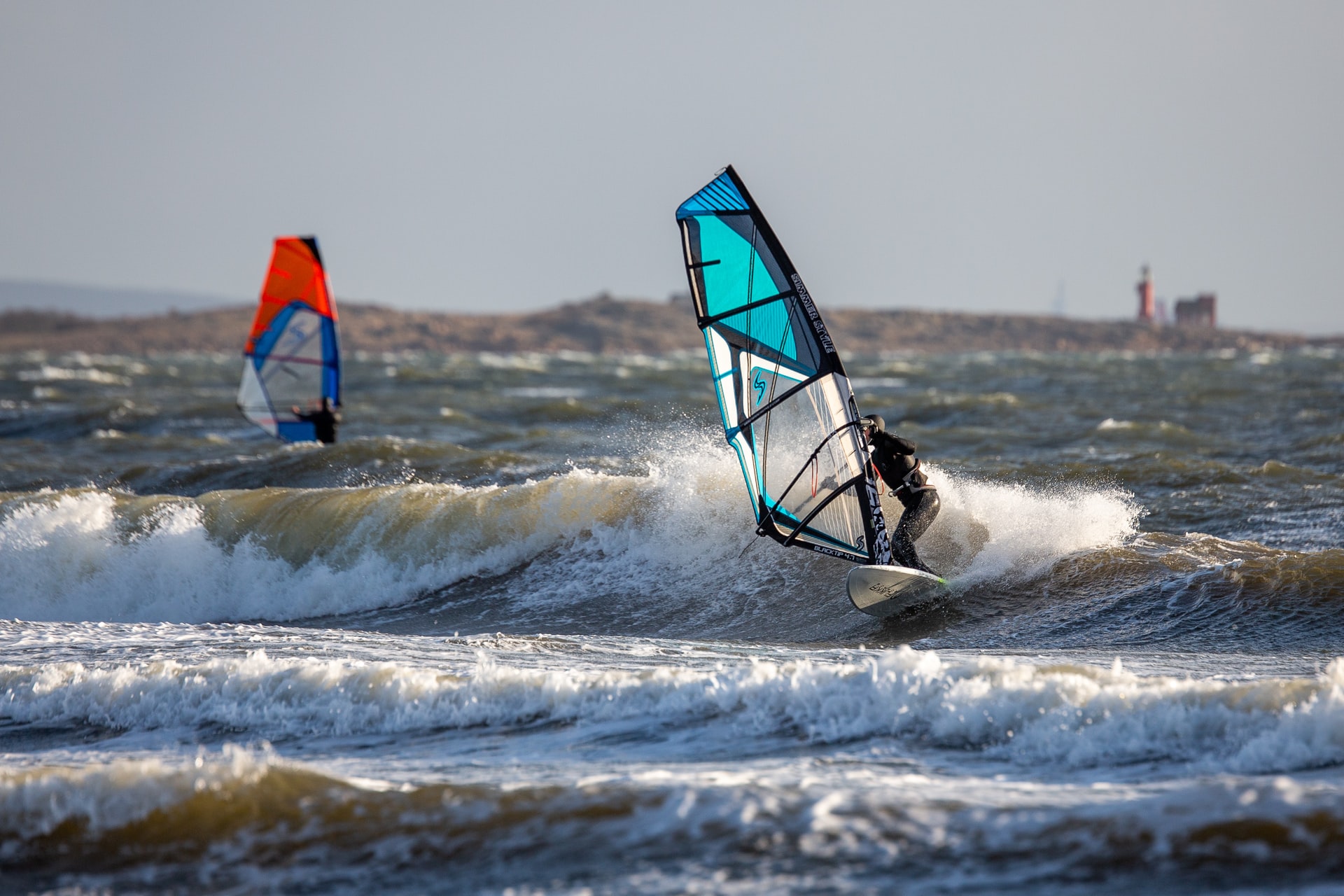
Surfing vs. Windsurfing: 8 Major Differences (& 4 Similarities)
-
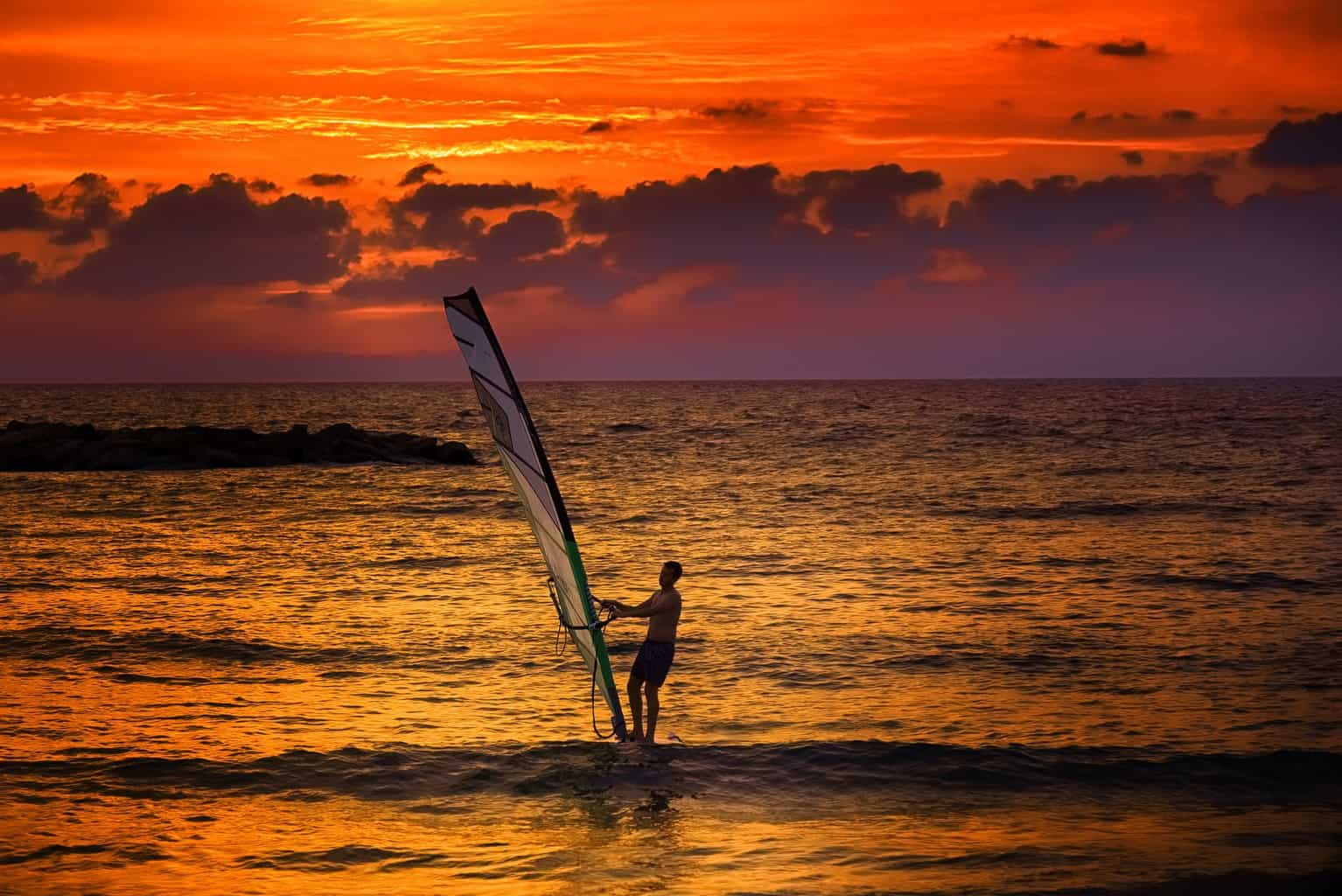
How Does Windsurfing Affect the Environment? (+8 Practical Tips)
-
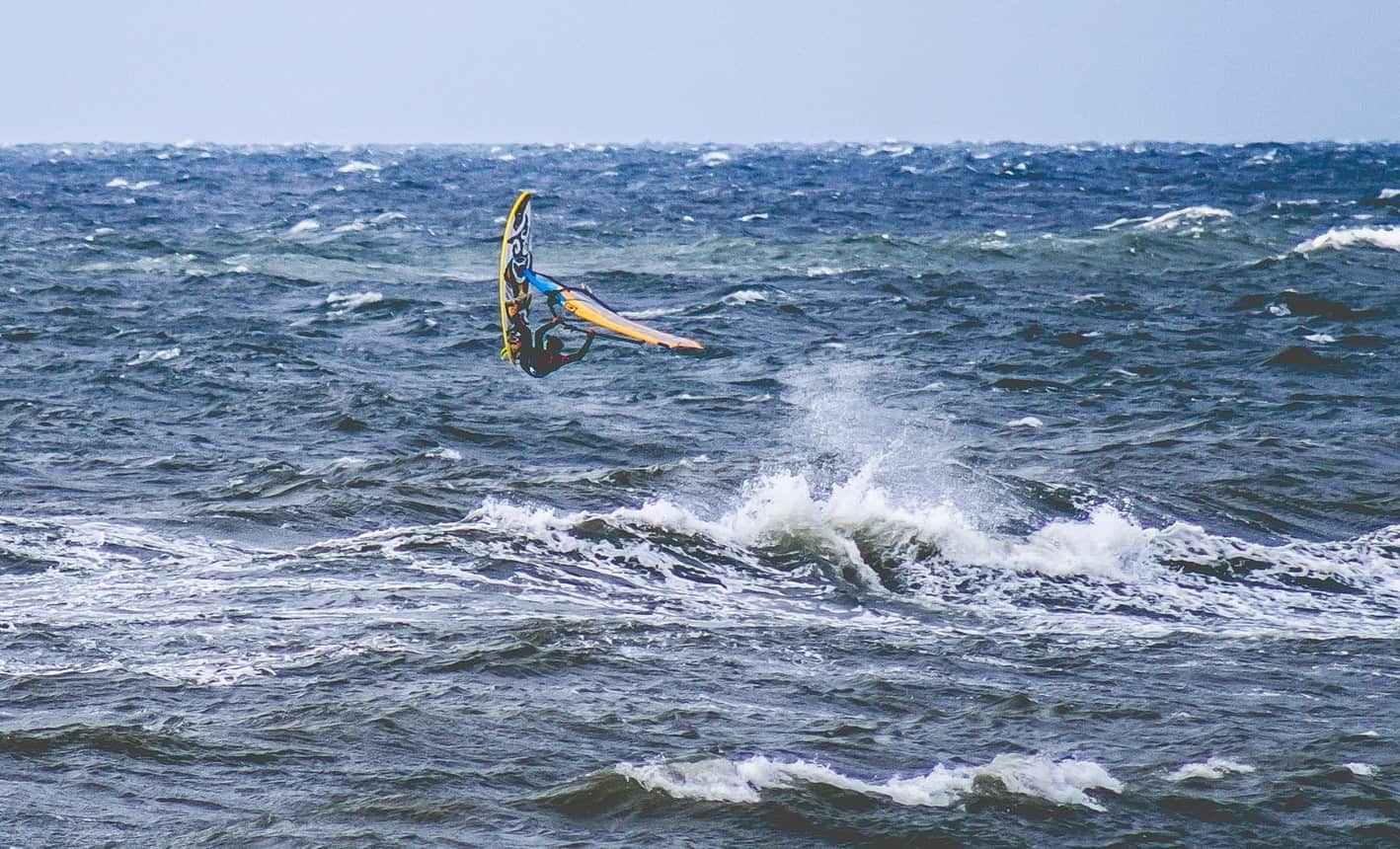
Is Windsurfing Dangerous? 14 Risks (& How to Avoid Them)
-
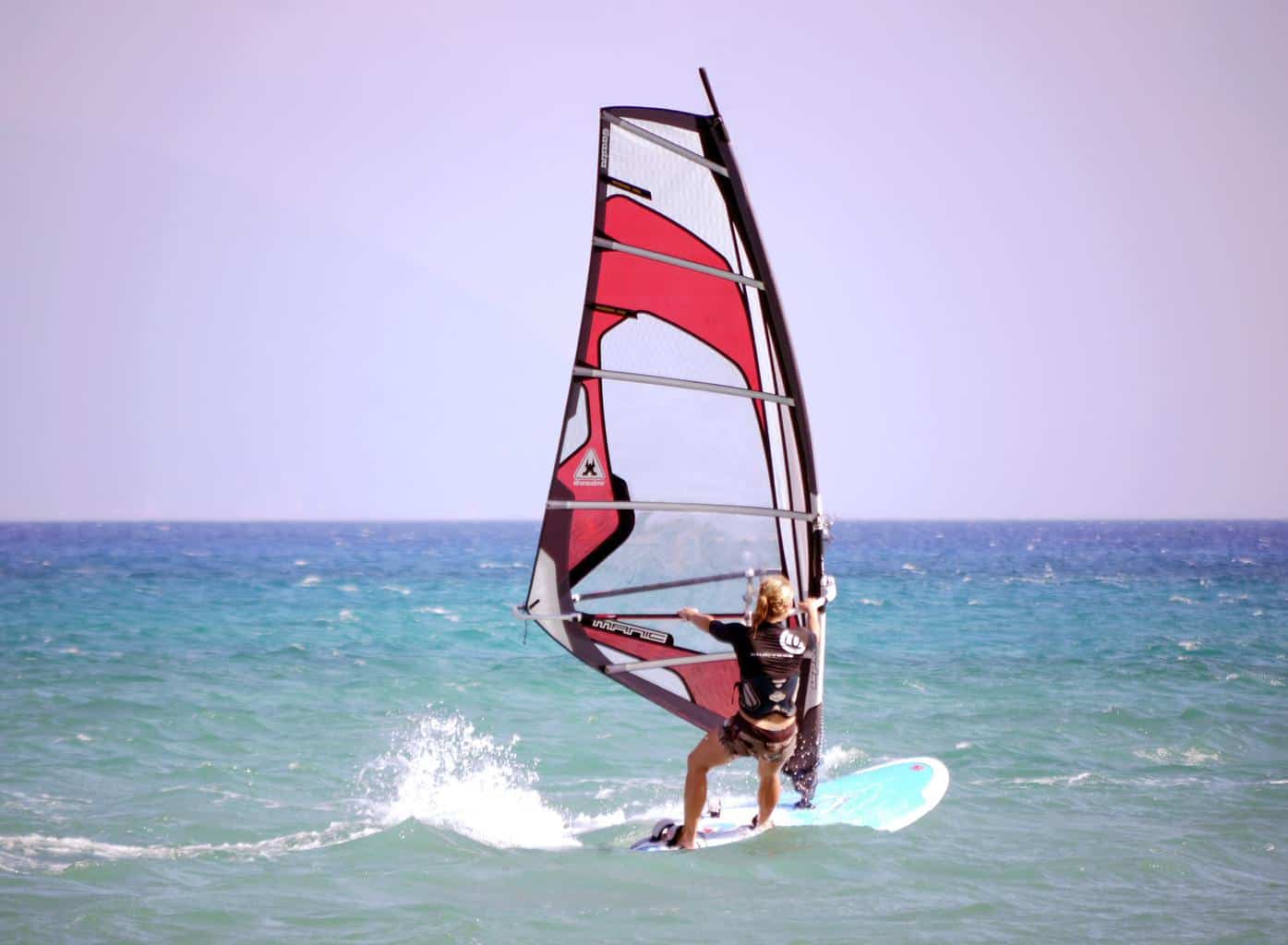
Windsurfing – 7 Common Beginner Questions (Answered)
-
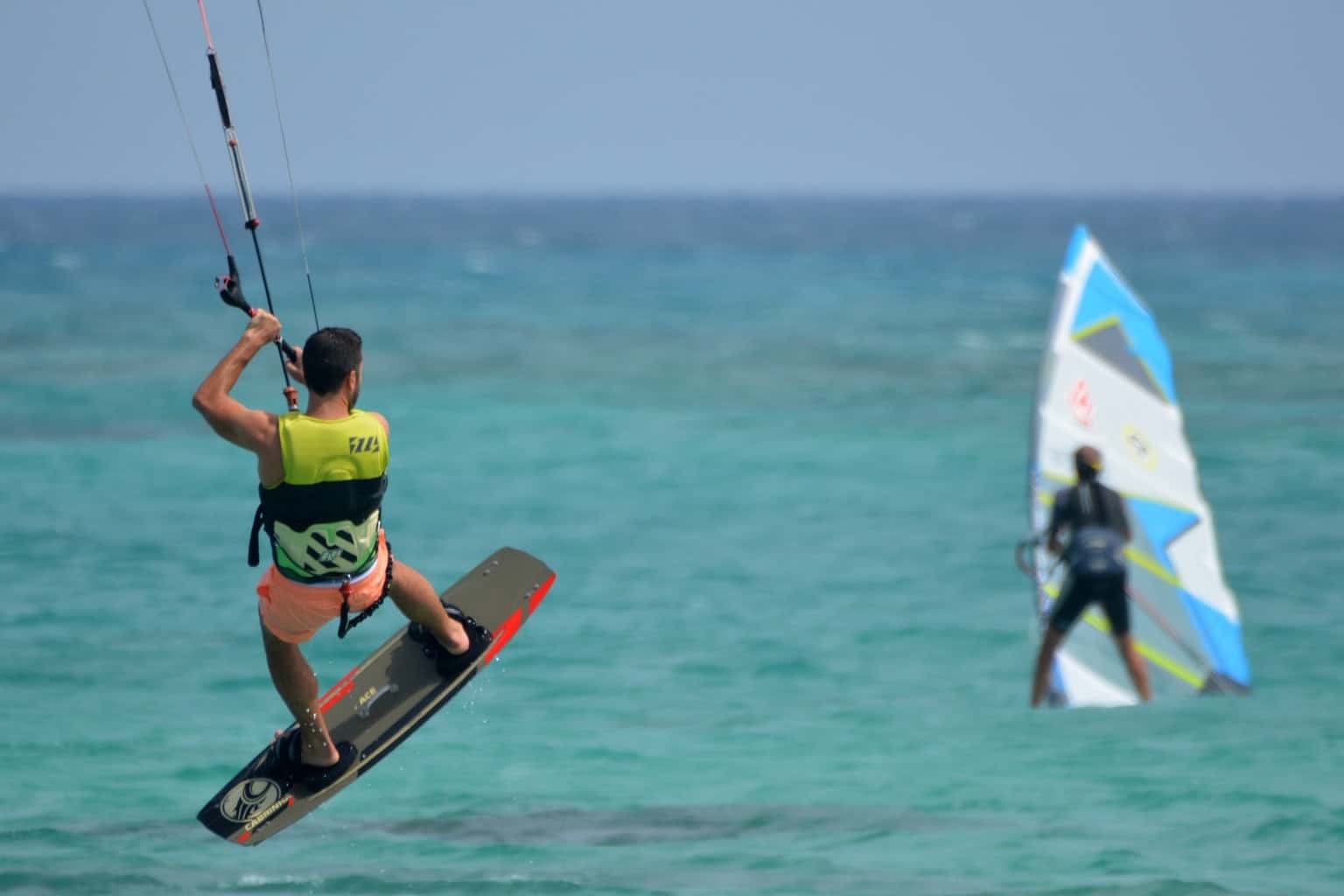
Is Windsurfing Faster Than Kitesurfing? (An Honest Look at the Facts)
-
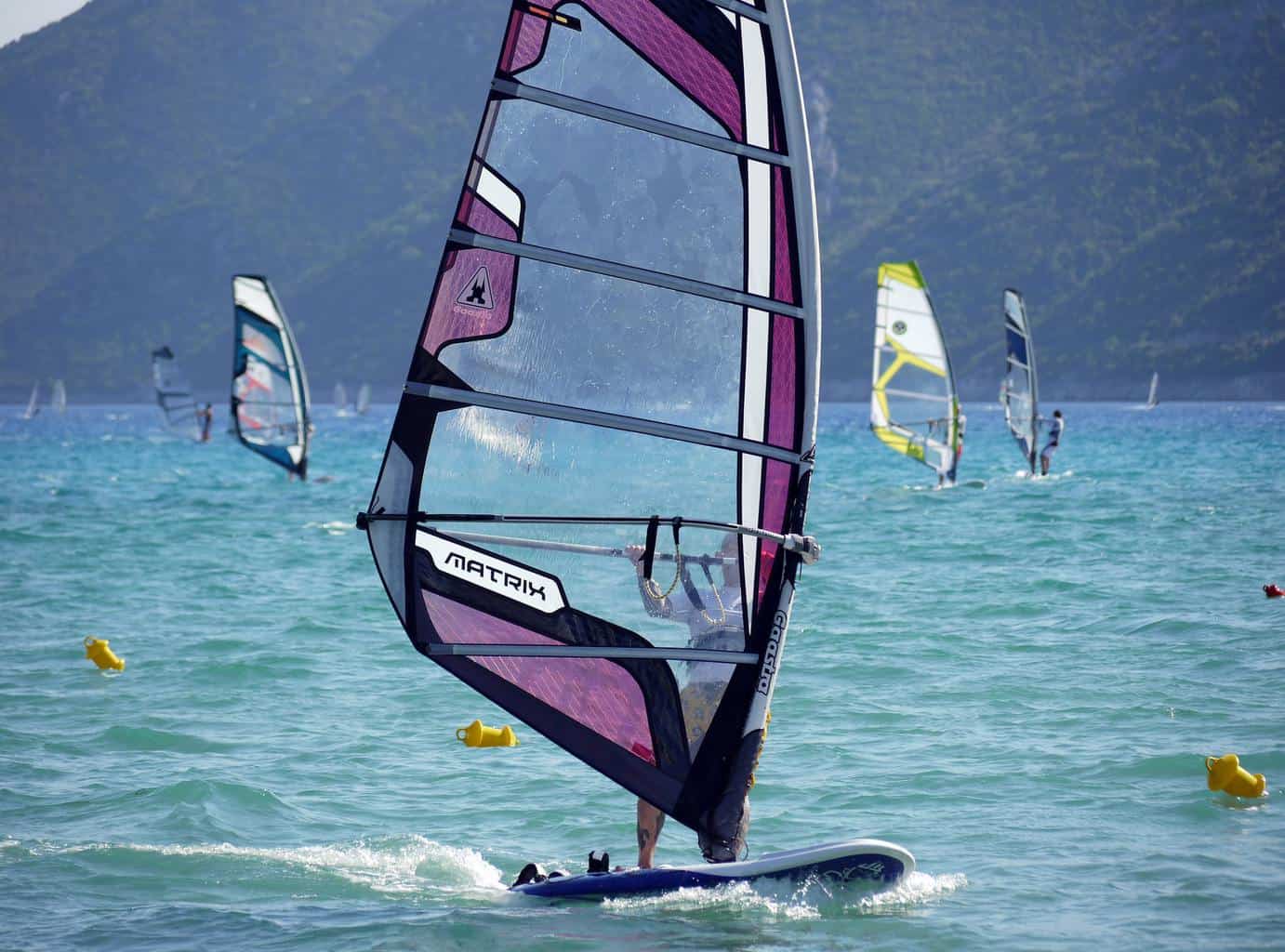
How to Choose the Right Windsurfing Sail Size (With Chart)
-
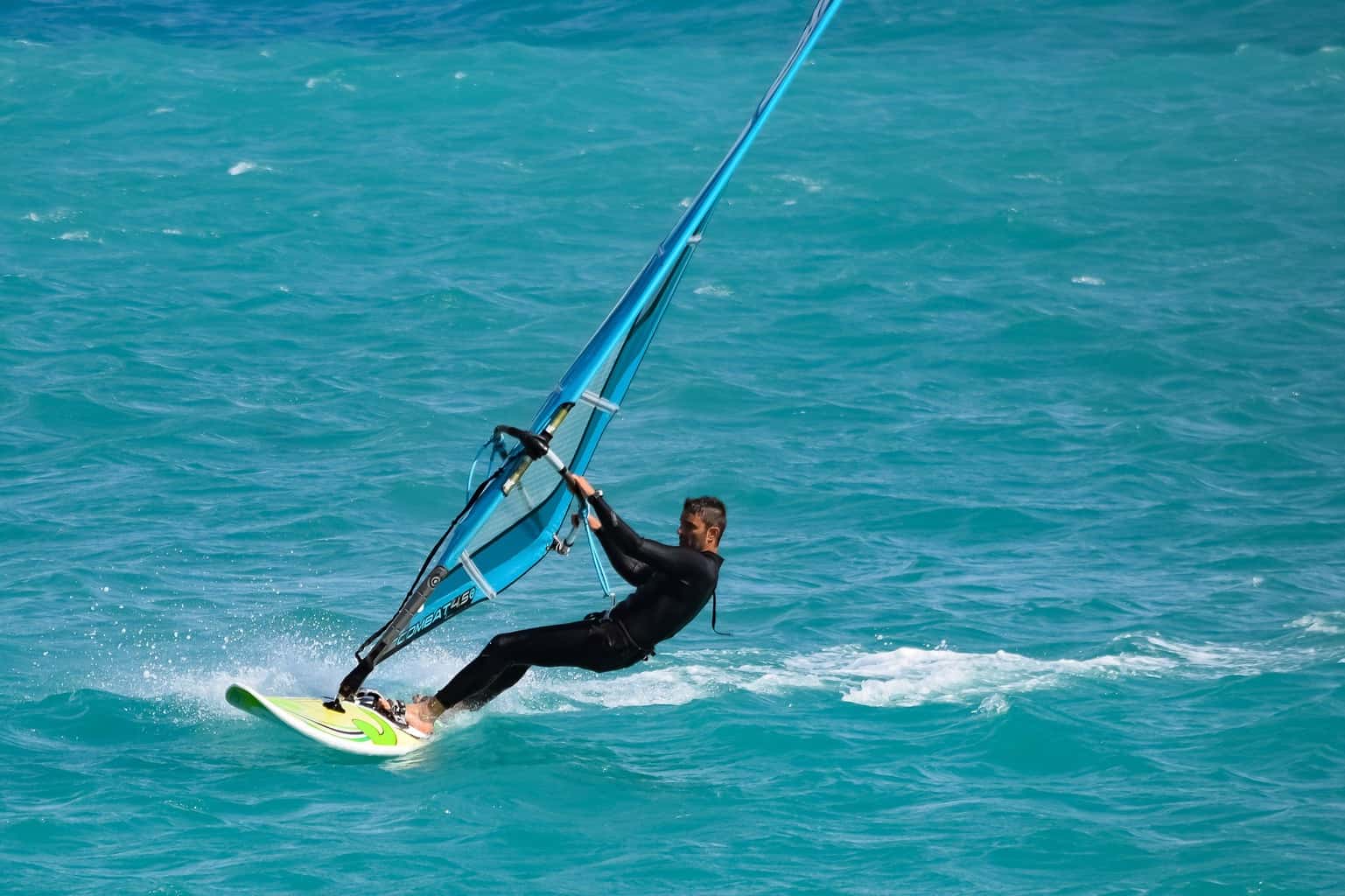
Windsurfing: How Much Downhaul Is Needed? (Essential Facts)
-
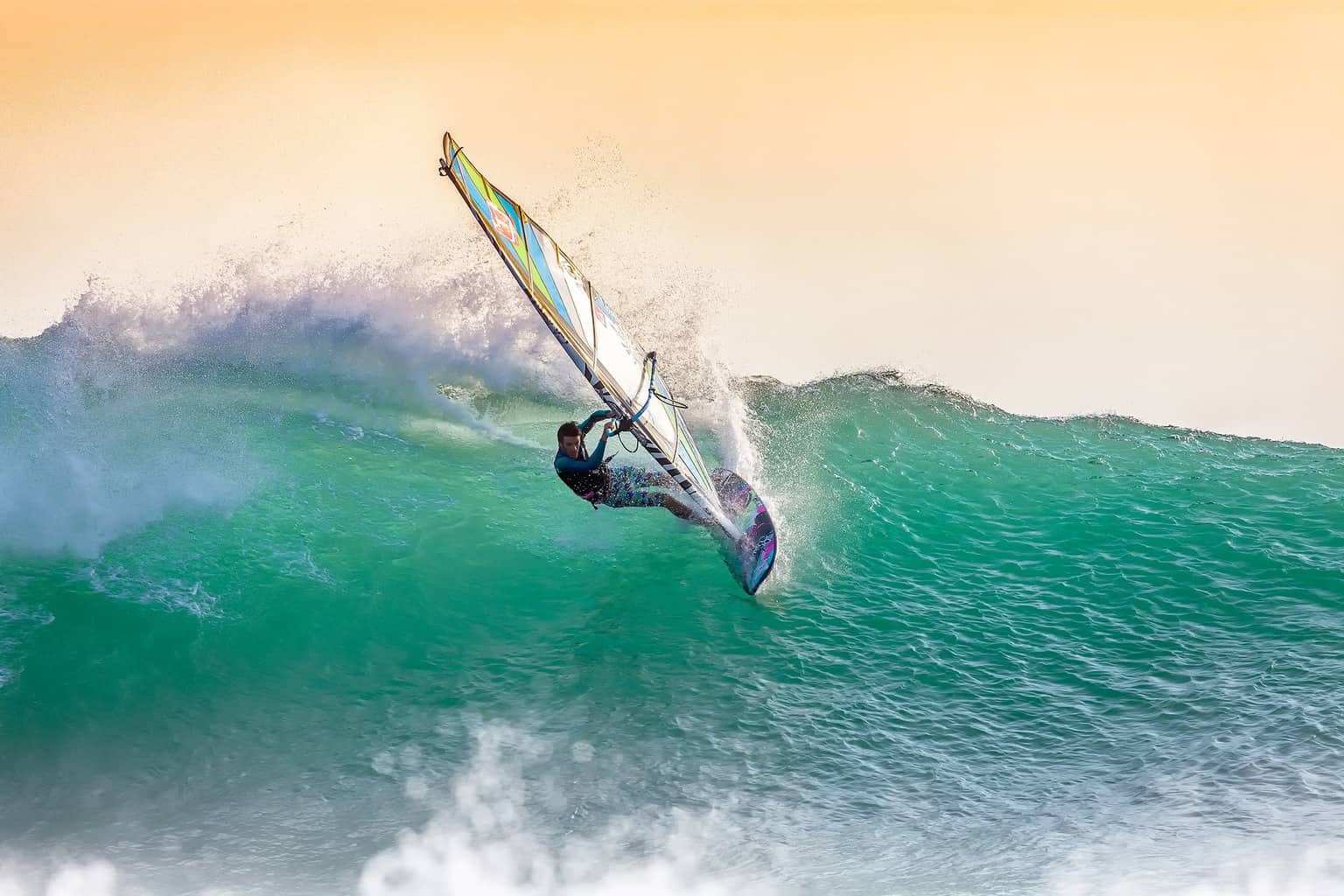
Is Windsurfing an Extreme Sport? (All You Need to Know)
-
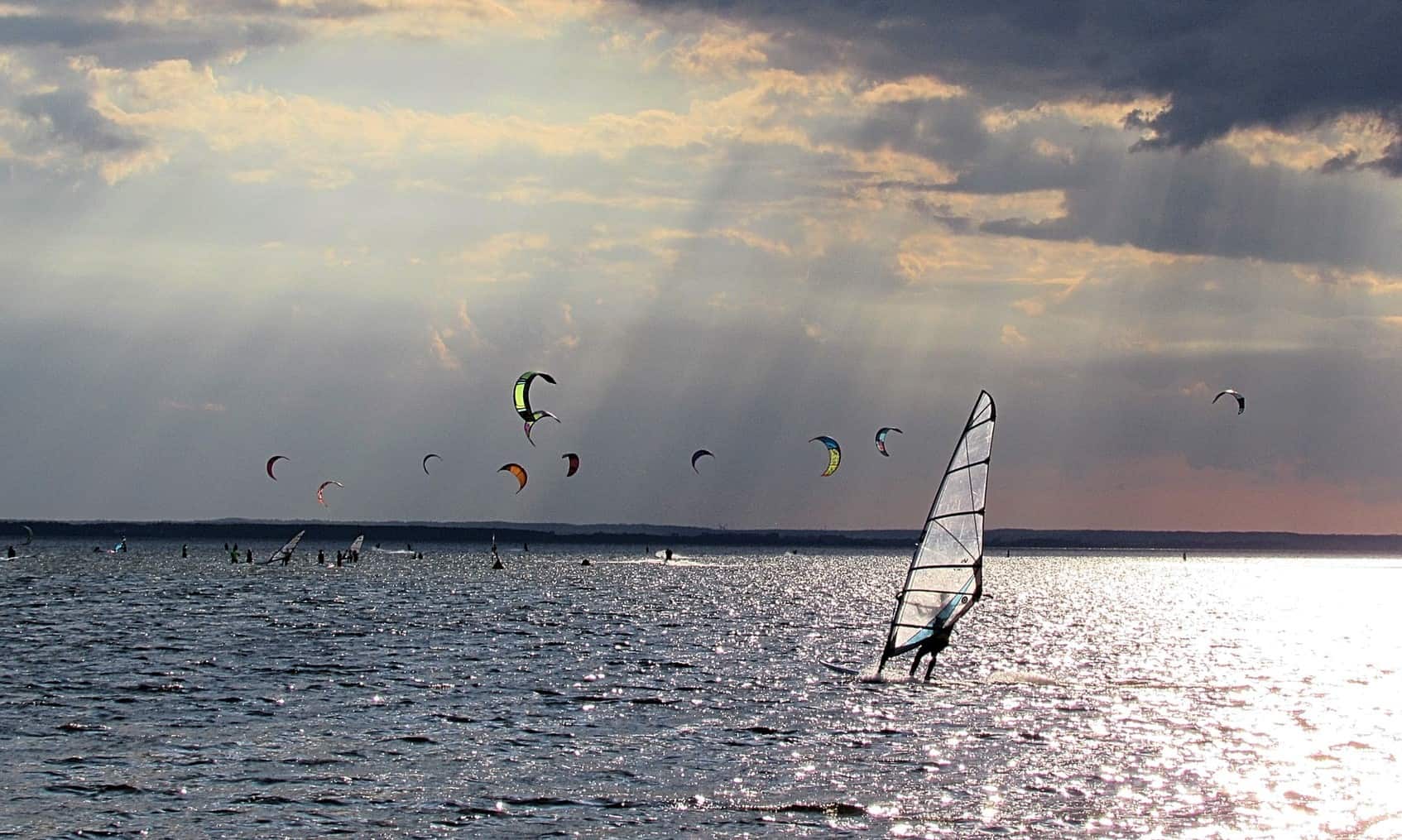
Is Windsurfing Easier Than Kitesurfing? (An Honest Comparison)
-
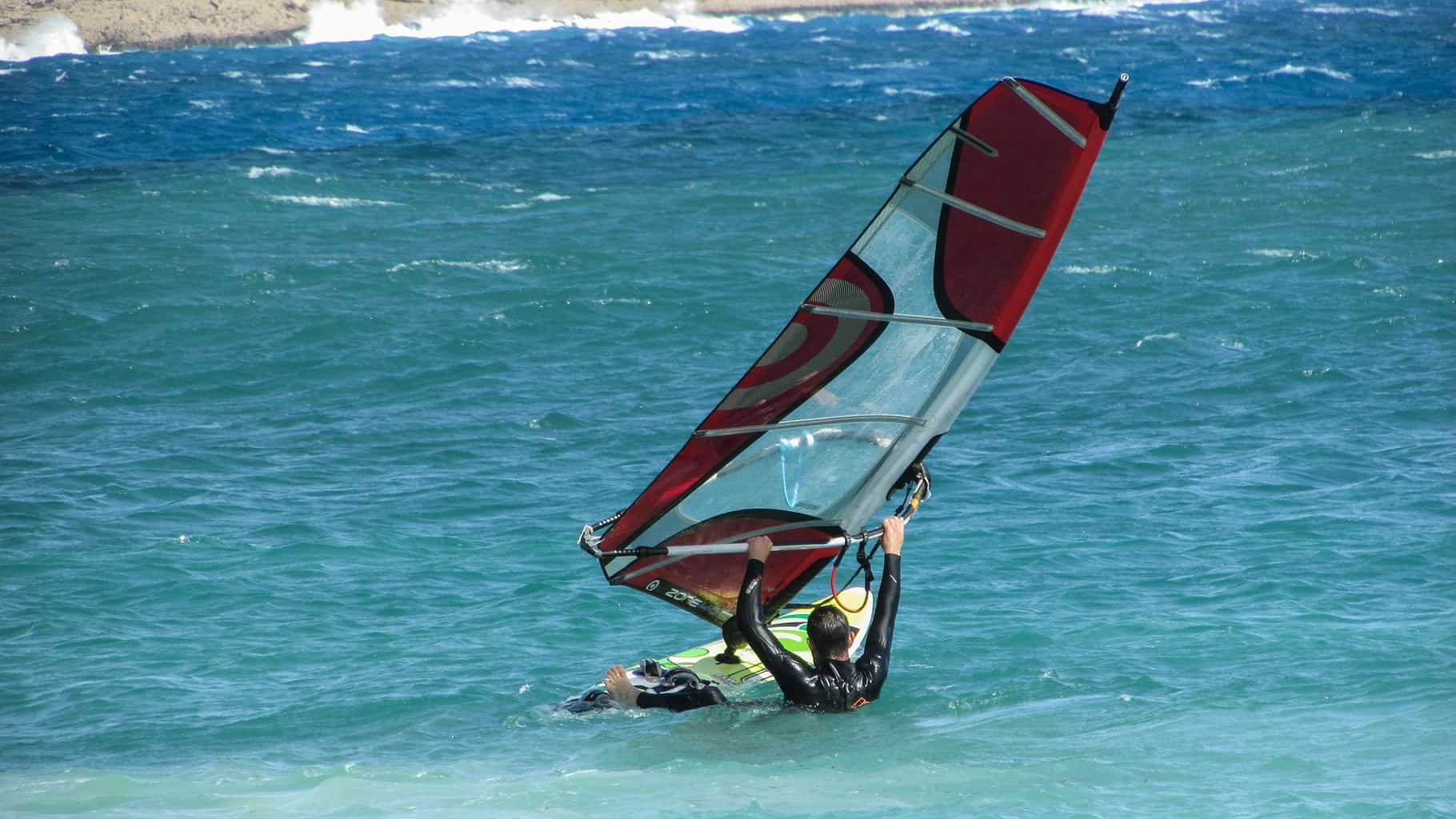
Is Windsurfing Harder Than Surfing? (Honest Comparison)
-
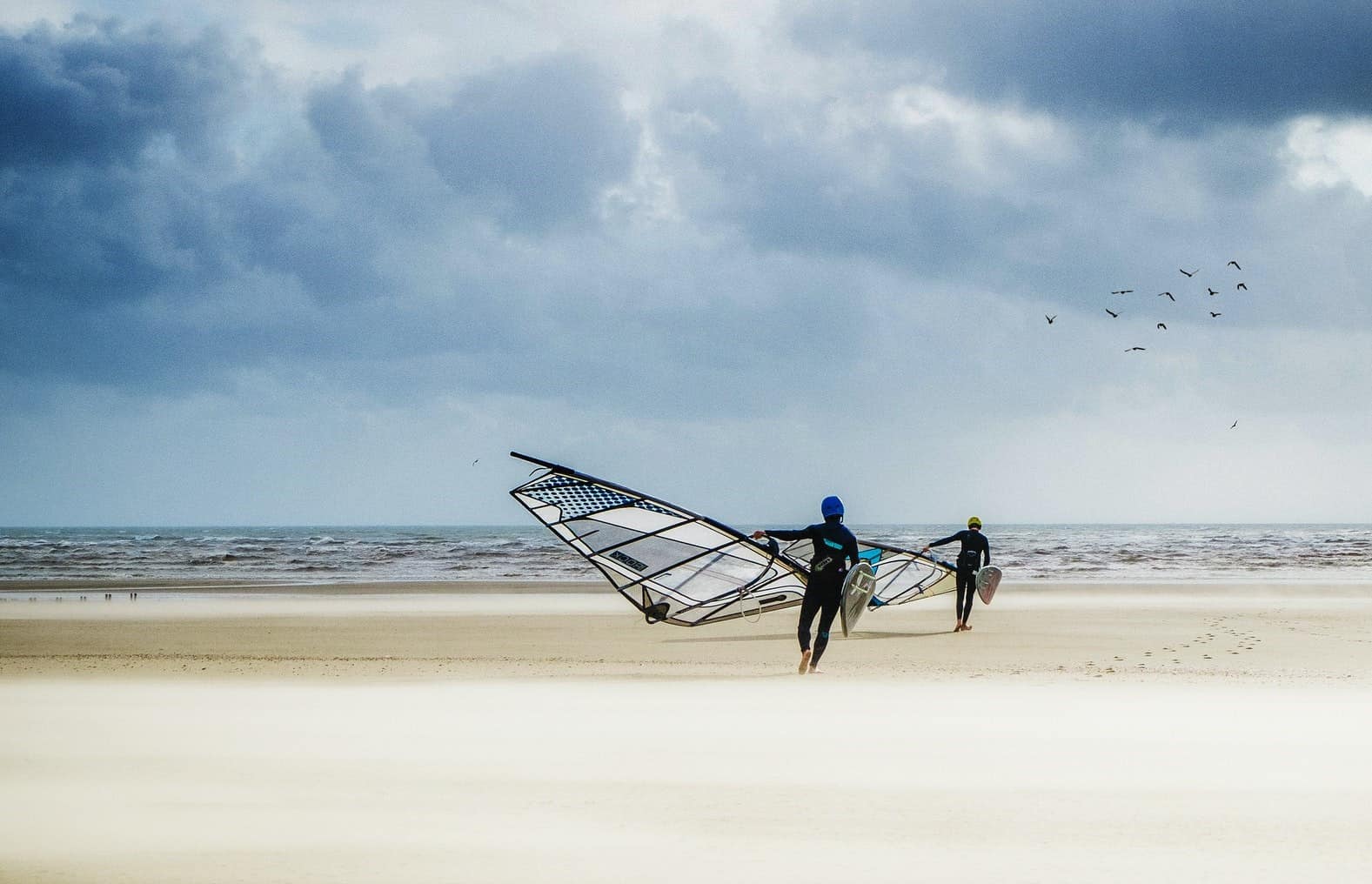
Is Windsurfing Still Popular? (An Insider’s Look at the Facts)










